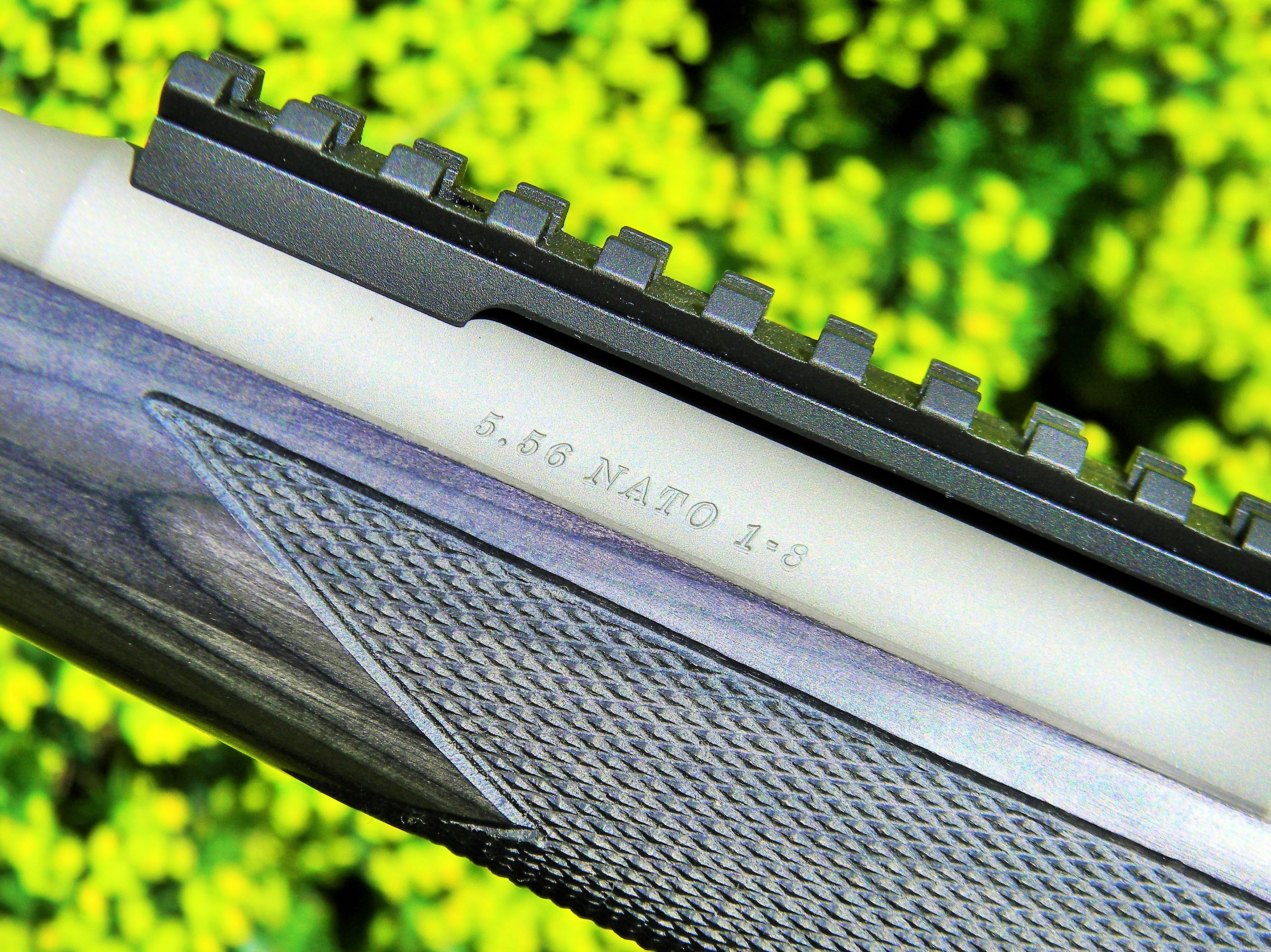
In the US, the Ruger Gunsite Scout in .308 Winchester has been hugely popular since its introduction four years ago. While the .308 is very popular in America, in ammunition sales the 5.56 mm cartridge far outsells the older round. Ruger finally stepped up and is now offering the Scout in the 5.56 mm cartridge, in both blued and stainless, with a black laminate stock, in both right and left hand versions. They feature a hybrid 5.56x45 mm chamber, which accurately and safely, also shoots the .223 Remington round.
Chapter 1: The New Offering
Click to LOAD DATA SHEET
Just like its older bigger brother, the length of pull is adjustable using ½” spacers, to between 12.75 ~ 14.25”, also resulting in an overall length of 37.0 ~ 38.5”. Weighing in at 7.1 lbs., it features a 16.1” barrel, a 1-8” RH twist rate, with ½”-28 threaded end, for a flash suppressor or alternate muzzle accessories. The smooth trigger pull ran around 4.5 lbs. with virtually no creep or overtravel. An extremely sturdy winged front sight is complimented by also having a removable rear peep. It comes with standard Ruger rings, and additionally a mid-position forward mounted Picatinny rail, which allows for mounting intermediate eye relief scopes or red dot reflex sights.
The .308 version 10-shot magazine was modified with spacers front and rear, to allow for loading 5.56 rounds up to 2.360” OAL. I found it could be loaded by either starting the cartridge near the front, then pushing it rearward, or by pushing straight down between the plastic feed lips, that reduce the metal lips meant for the .308, down to the narrower body of the 5.56/.223. While most Scout black laminated stocks are really a mixture of gray and black laminates, this particular stock on the test rifle, is virtually totally black in coloration, to the extent that I at first thought the rifle had a black synthetic stock.
I rounded up 10 different varieties of factory ammo, which was surprisingly hard to do, even seven years after the initial huge ammunition demand, which was created by political change in the US. Eleven different projectiles were also gathered up, from 35 to 85 grains, to see how the 1 in 8” twist rate would handle...
a variety of weights and bullet lengths. A conventional scope, a Leupold VX-III in 3.5-10x40 mm, was rear mounted for testing. Finally the huge task of reloading began, to see how well I could get the new 5.56 Scout to shoot.
Chapter 2: Factory Ammo Performance
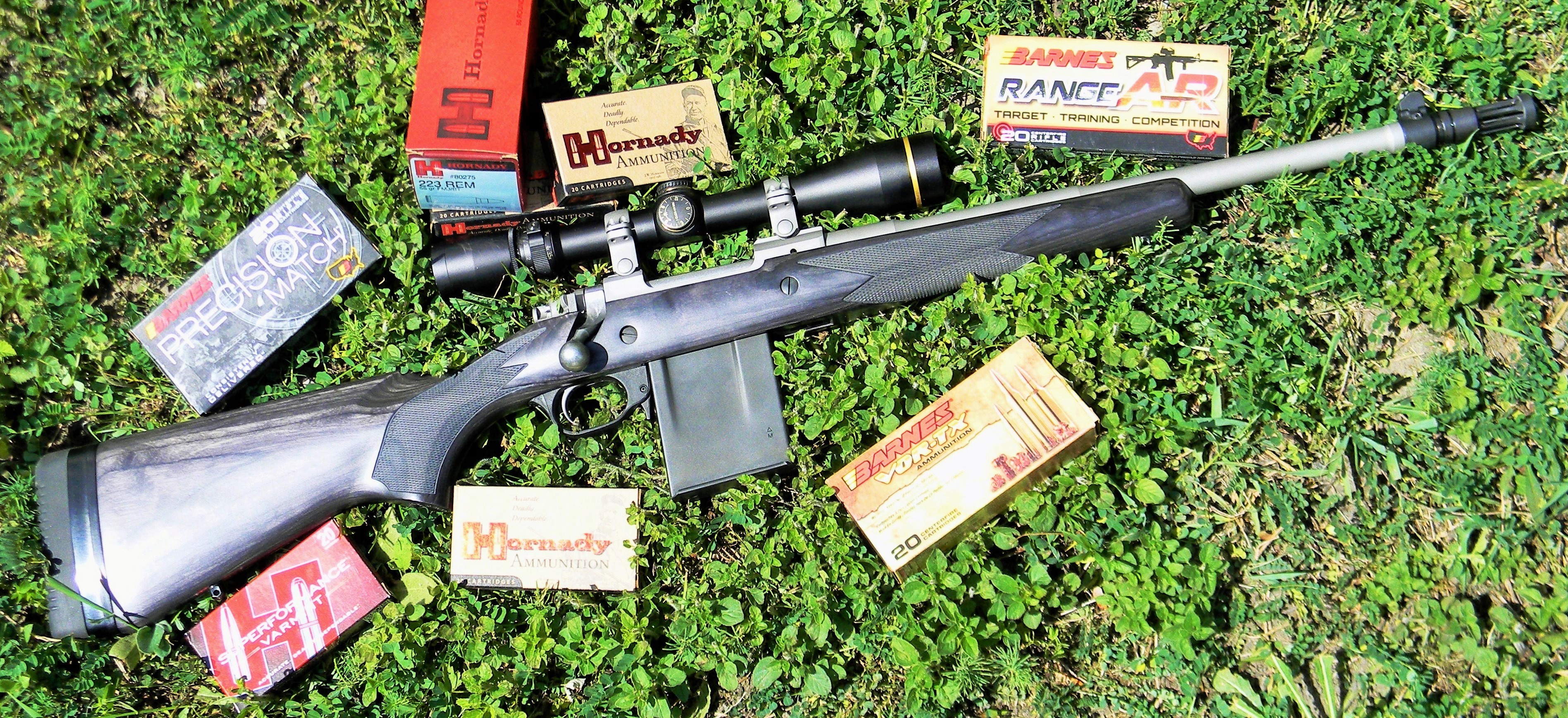
Hornady came through with factory loads in 40, 53, 55, 68 and 75 grains. Barnes was able to provide a 52 grain lead-free round, as well as an 85 grain match load. I also ran a steel cased FMJ round through the rifle. Surprisingly, the Ruger’s 1 in 8” twist did a commendable job firing 5-shot groups with all varieties, except the bargain steel cased ammo. The Hornady 40 grain V-Max produced 3,252 fps, shooting into 0.78” for 5-shots at 100 yards. Their Superformance 53 grain V-Max load just broke 3,100 fps, and averaged 0.81”.
A little slow in comparison, but surprisingly accurate, the bulk 50 round box of 55 grain FMJ/BT “plinking ammo” delivered 2,592 fps, but did shoot very well at 0.79” groups. Offering two 55 grain loads, one a V-Max and the other a GMX monolithic hunting load, they respectively shot into 0.92 and 1.15”. The V-Max produced 2,679 fps, while the hunting load reached 2,808. The 68 grain Match load shot into 0.86”, while reaching just over 2,630 fps. Their 75 grain BTHP MATCH load was very good, at 0.68” and 2,560 fps. I had requested another half-dozen loads or so, but production is still having a hard time keeping the supply system full with all of their many offerings.
Barnes sent three loads for the rifle, two specifically labeled as for the 5.56x45 mm cartridge, and one for the .223. Note that all Hornady offerings were labeled as being for the .223. The Barnes Range AR ammo, consisted of a 52 grain lead-free, zinc-cored, jacketed hollow point, flat base. It would be great for steel plate competition, as the compressed powdered core turns back to dust on impact. Not only was it accurate, producing 0.90” groups, but also fast, at almost 3,100 fps. The .223 labeled Vor-TX round is a hunting load, featuring their 55 grain TSX solid copper expanding game bullet. At almost...
2,800, shooting into 0.79” 5-shot groups, it would also serve well for those wanting to hunt with an AR-15. This practice is becoming more popular every dayin the US, especially for feral hog hunting in the south. The final load they sent for testing was a real joy to shoot.
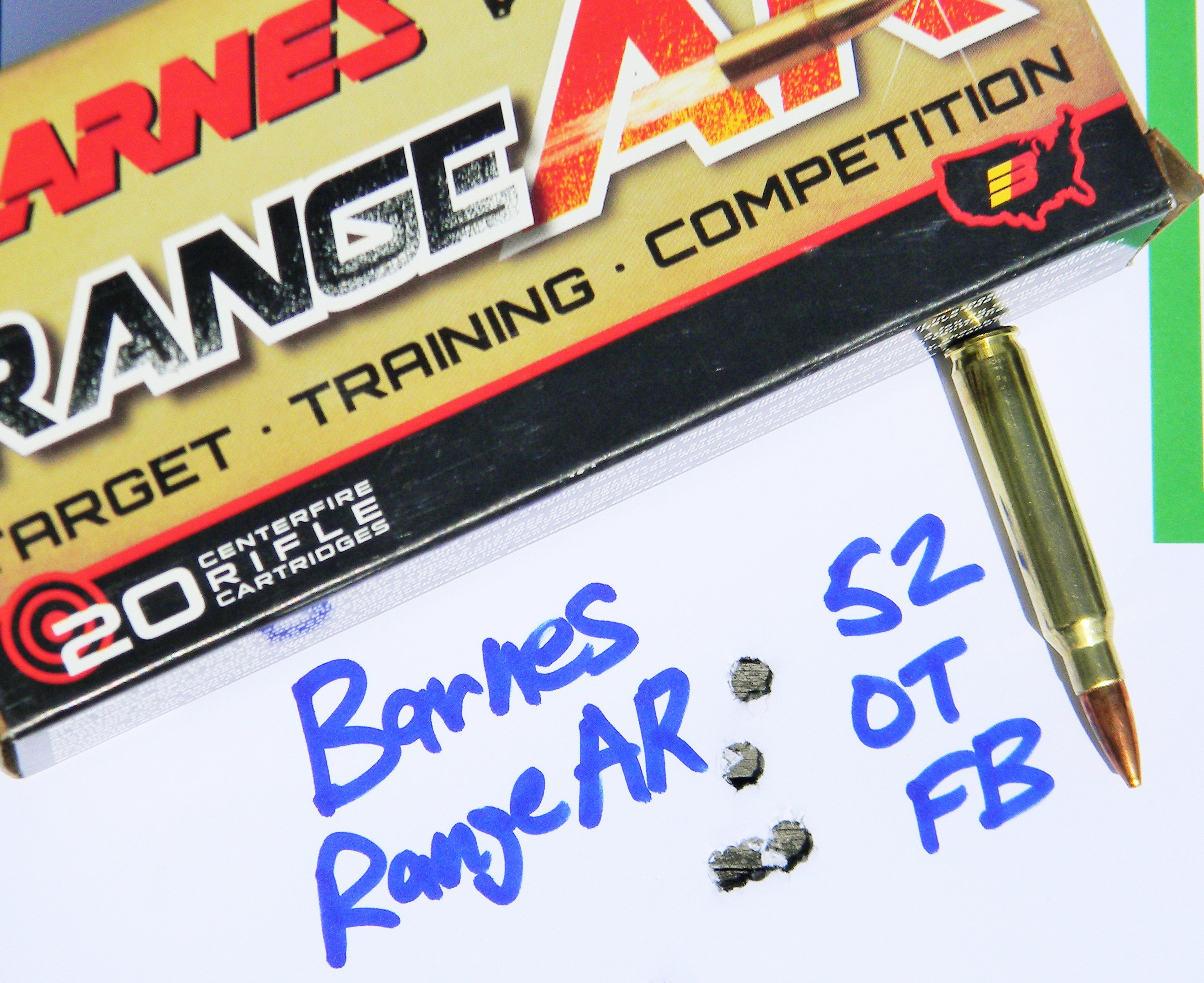
From their Precision Match line labeled as “caliber 5.56x45 mm”, it features a lead core, 85 grain Open Tip Match, Boattail projectile. At almost 2,500 fps from the short barrel of the Scout, it was enjoyable to shoot consistent 0.69” 5-shot groups again and again at 100 yards. I’m happy to report that you can just slightly beat that accuracy by loading your own with the same bullet, and Alliant RL-15, but it shoots slightly slower at 2,372 fps. Good to know if you want to try a heavy match bullet, but can’t get your hands on any of this ammo. Alternately, with Hodgdon’s CFE223 powder, it did get a little more speed at 2,394, and almost as good accuracy, shooting into 0.76”. The most accurate load with this bullet was 22.6 grains of Hodgdon’s H4895, good for 0.67” groups, and 2,304 fps.
Finally, a friend gave me a box of “plinking” steel cased ammo, loaded in Russia with 55 grain FMJ bullets. It was fairly fast at 2,810 fps, but only shot into 1.90”, which is fine for the intended use, and especially considering its low cost.
Chapter 3: Reloading for the Scout
The first bullet I tried proved to be very interesting. Hornady’s 35 grain V-Max is a stubby tipped bullet, meant for the very slow 1-16” twist rate of the .22 Hornet cartridge. I like it for milder, quieter loads, as it expands like you can’t believe, even at well below .22 Magnum rimfire velocities. As MELs- or Moderate Effective Loads- using Alliant Blue Dot, I realized speeds from 3,000 ~ 3,300 fps on only up to 16 grains of powder, with 5-shot groups running between 0.72 and 1.11” at 100 yards. As I took it faster with more conventional powders, the speeds climbed to just over 3,600 fps, but the group size also almost doubled. What was going on? A little simple math confirmed my suspicion.
A 150...
grain hunting bullet fired from a .30-06 with a 1 in 10” twist rate, results in around 216,000 rpm, noting that the bullet has a fairly thick jacket. A 35 grain V-Max fired from the .22 Hornet with a slower 1 in 16” twist rate, at the same speed as the 150/.30-06 projectile, is only spinning at 135,000 rpm. But the Ruger Gunsite Scout has a twist rate TWICE as quick as a typical Hornet.
So at around 3,000 fps, the Hornet bullet from the Scout is doing 270,000 rpm- it’s amazing it could even hold together at that speed!
My fastest and most accurate MEL- 3,331 fps grouping into 0.72”- was spinning at just under 300,000 rpm. But please note… my top loads with that bullet reached 3,637 fps, resulting in just over 327,000 RPM!
I’m amazed any of the thin jacketed V-Maxes even made it to the 100 yard target, and could still produce 1.30” groups. All things considered, a MEL with this bullet would probably work well on prairie dogs or foxes, out to 200 yards or so. But you should be careful to not take the speed up too high; else the far side of a fox pelt could be excessively damaged.
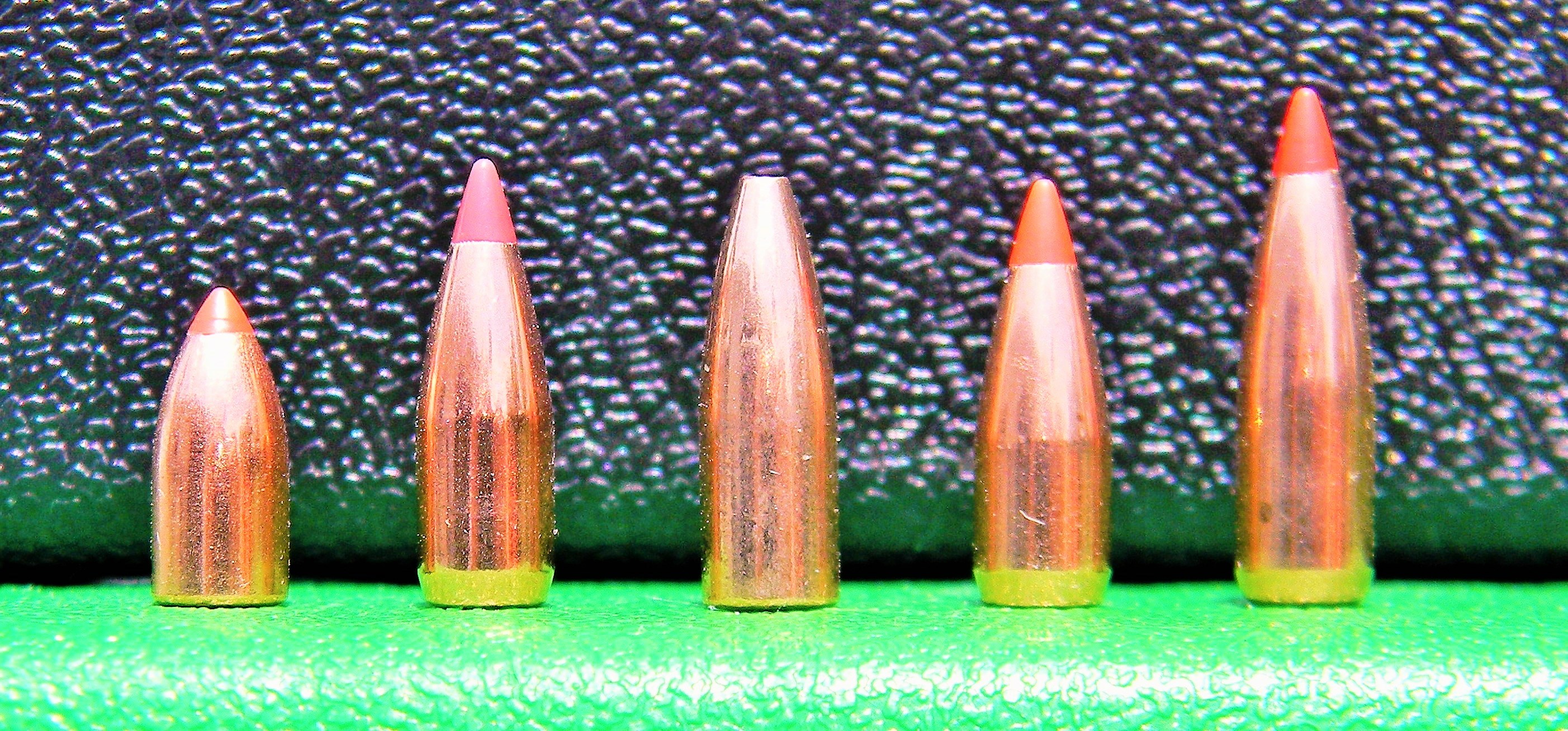
The 35 grain Hornady lead-free NTX tipped boattail, was very accurate as a MEL over 14 grains of Blue Dot, good for 0.78” groups at 3,103 fps. Vihtavuori N120 pushed it to 3,790, and produced 0.85” 5-shot groups. Their 40 grain lead cored V-Max also shot to the same speed and accuracy level as the 35 grain NTX as a MEL, so the two loads could be used interchangeably. The most accurate full power loads with the 40 grain V-Max used Alliant RL-7 or Hodgdon H335 for around 3,370 fps, and 0.68” groups. Vihtavuori N120 and N130 reached between 3,467 and 3,620 fps, and shot into around 0.82” with this bullet.
Hornady’s 53 grain V-Max was accurate at 0.74” as a MEL, producing 2,757 fps from only 14.7 grains of Blue Dot. The best full-power load featured N130 for 3,149 fps, and 0.86” groups. For some reason the Scout did not do as well with their 55 grain GMX monolithic expanding hunting bullet. Almost ten powders...
were tried, but the five best shooting ones delivered groups from 1.2 ~ 1.4”, at speeds of up to almost 3,100 fps. None of the 50 grain GMX bullets were available at the time, but perhaps that lighter bullet might be preferred by the Ruger Scout. The 60 grain V-Max produced 0.73 to 0.79” groups, at around 2,820 to 2,900 fps, using Hodgdon BL-C2, H335 or Vihtavuori N530.
The Barnes 69 grain Match Burner, OTM BT (Open Tip Match, Boattail) fortunately delivered its best accuracy of around 0.71”, with powders that give it the highest velocities. Alliant RL-15 produced almost 2,800, while IMR 4895 was slightly faster still. Try as I might, using the 75 grain Hornady A-Max, I couldn’t even approach the factory BTHP Match load for accuracy. The best the A-Max would do with handloads was 1.05”, but at only 2,468 fps on Hodgdon’s CFE223.
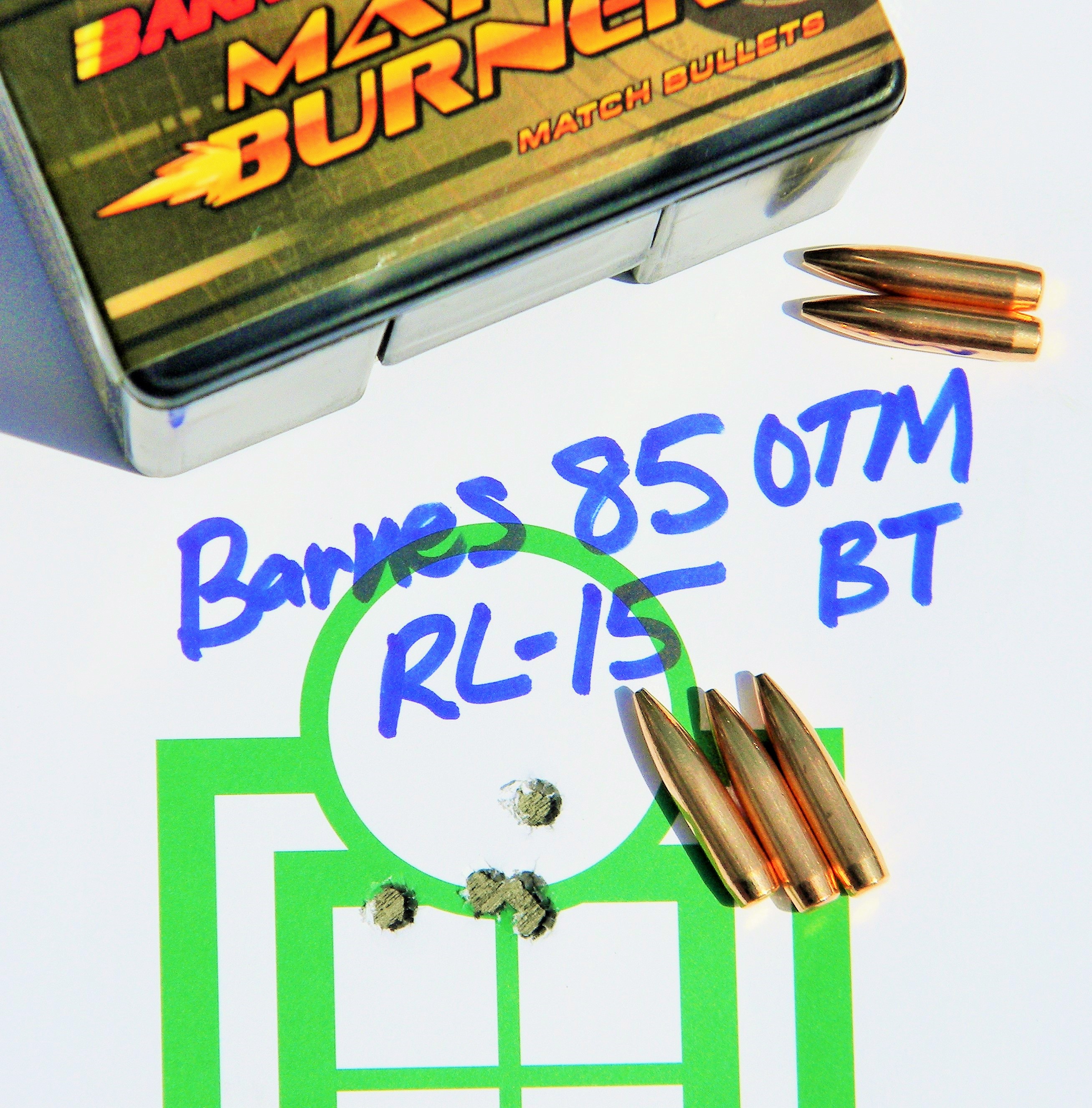
Of the reported 70 handloads, the most accurate load in the short barreled Gunsite Scout- was the Barnes 85 grain Match Burners, Open Tip Match, Boattail. I regularly achieved 0.64” 5-shot groups at 100 yards, using Alliant RL-15 for 2,372 fps. Often times three or more of the rounds would make a single ragged hole, with one or two just outside the cluster. Hodgdon H4895 shot into 0.67”, and was just slightly slower at 2,304 fps. I find this to be exceptional accuracy for a rifle designed more to be a working gun, for a survivalist or a rancher, not a competitor.
Chapter 4: Summary
The Scout rifle concept, also allows for having a 6” long Picatinny rail mounted to the barrel, just in front of the receiver. This allows the shooter to mount a long eye relief scope, or any other long eye relief optics. After loading and firing over 1,000 rounds in the Gunsite Scout, I ran out of time, which kept me from seeing what could be done with such a setup. The work has been done though for other shooters, as you could try a few of the best shooting loads in your gun, with optics mounted on the forward rail.
One important note about the standard Ruger rings, supplied for mounting a conventional scope on...
the receiver. The gun came with 1” stainless rings, with the designated size of 4K (for the front position) and 5K (for the rear). Ruger also manufactures a lower height 3K, and their highest, designated a 6K ring. When I tried to mount a 3-9 power scope with a 40 mm front objective, the supplied rings were too low, causing the front to contact the Picatinny rail, well before the tube was fully seated. I had to then remove the rail, in order to mount the scope with the supplied rings. That sort of defeats the purpose of having a handy, compact rifle, capable of being used with open sights, a conventional rear mounted scope, or a front mounted long eye relief optic.
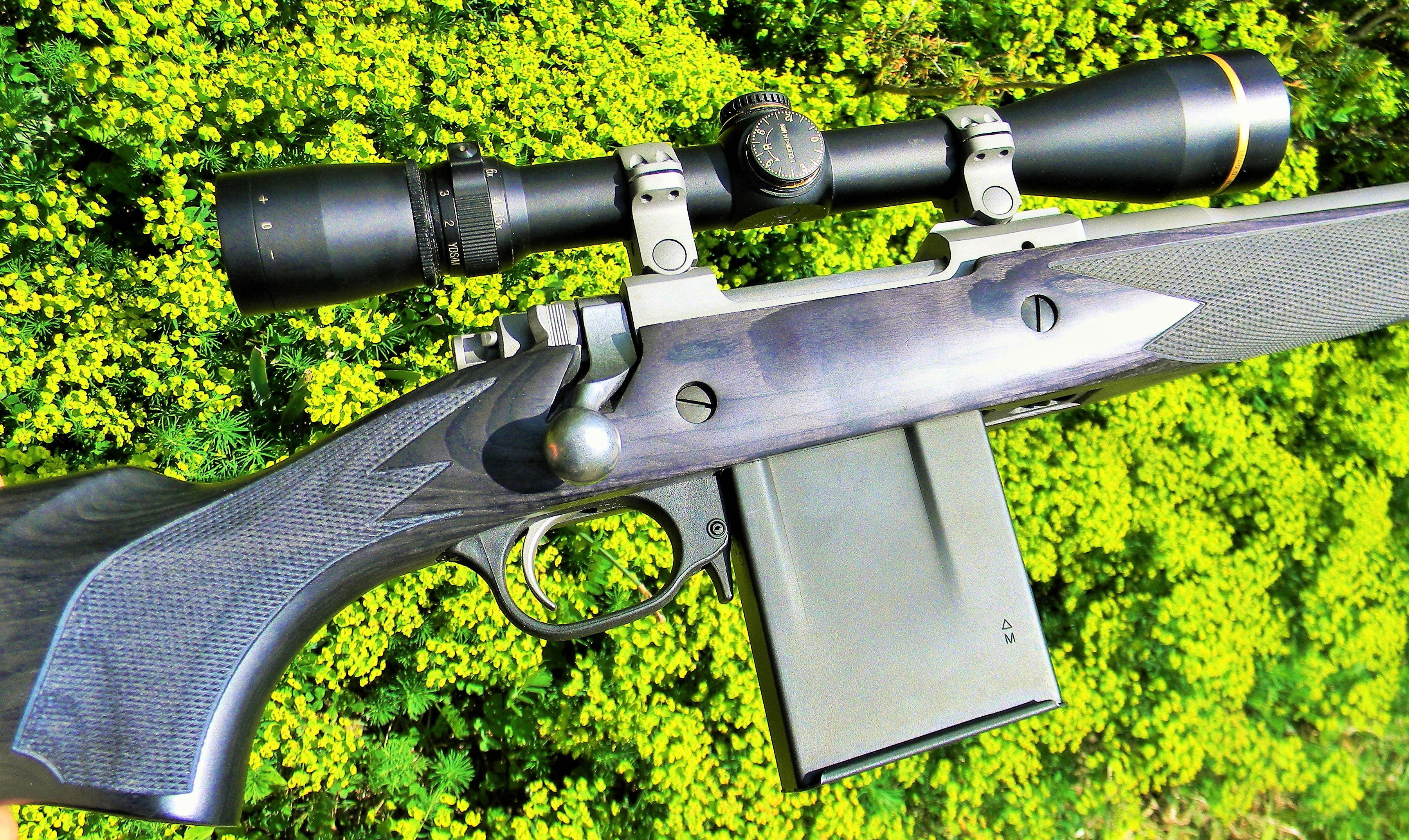
If Ruger provided all Scouts with a set of rings in their sizes of 5K and 6K, then for certain the most common scopes with 40 mm objectives could be mounted, without having to remove the neat Picatinny forward rail.
Other than that, I was very pleasantly pleased with the overall execution by Ruger, and especially the accuracy I obtained with ten factory loads, and my almost six-dozen now proven handloads. My average for all eighty loads tested, came in at a very impressive 0.96”. When I first started shooting four decades ago, a heavy barreled varmint rifle which shot that well, would have been something to brag about. Well done Ruger, well done.